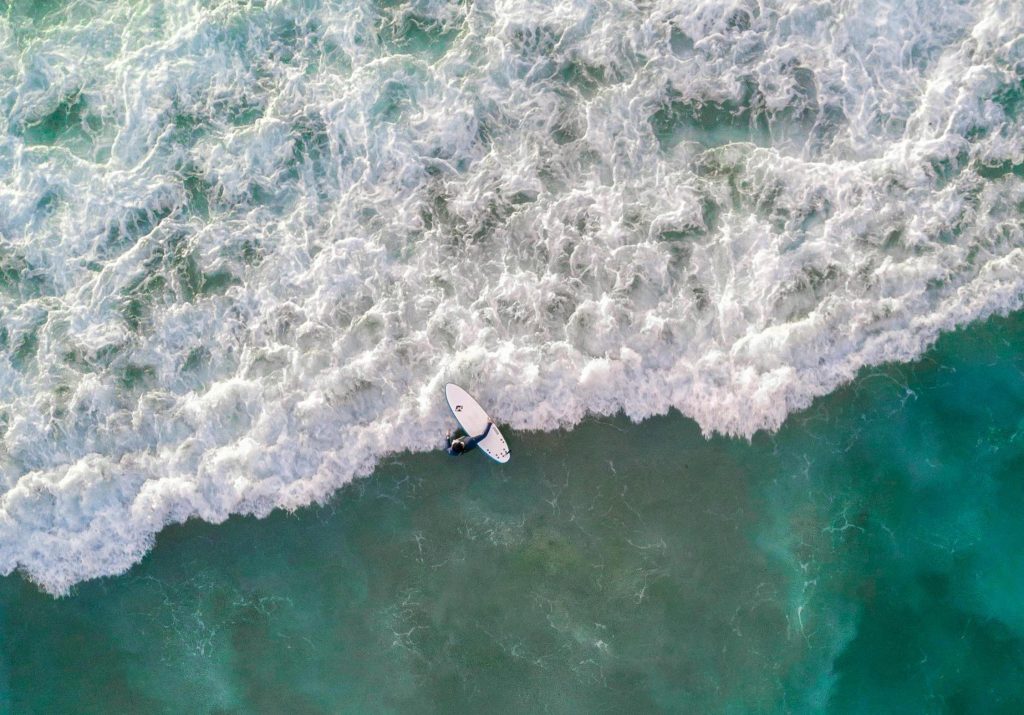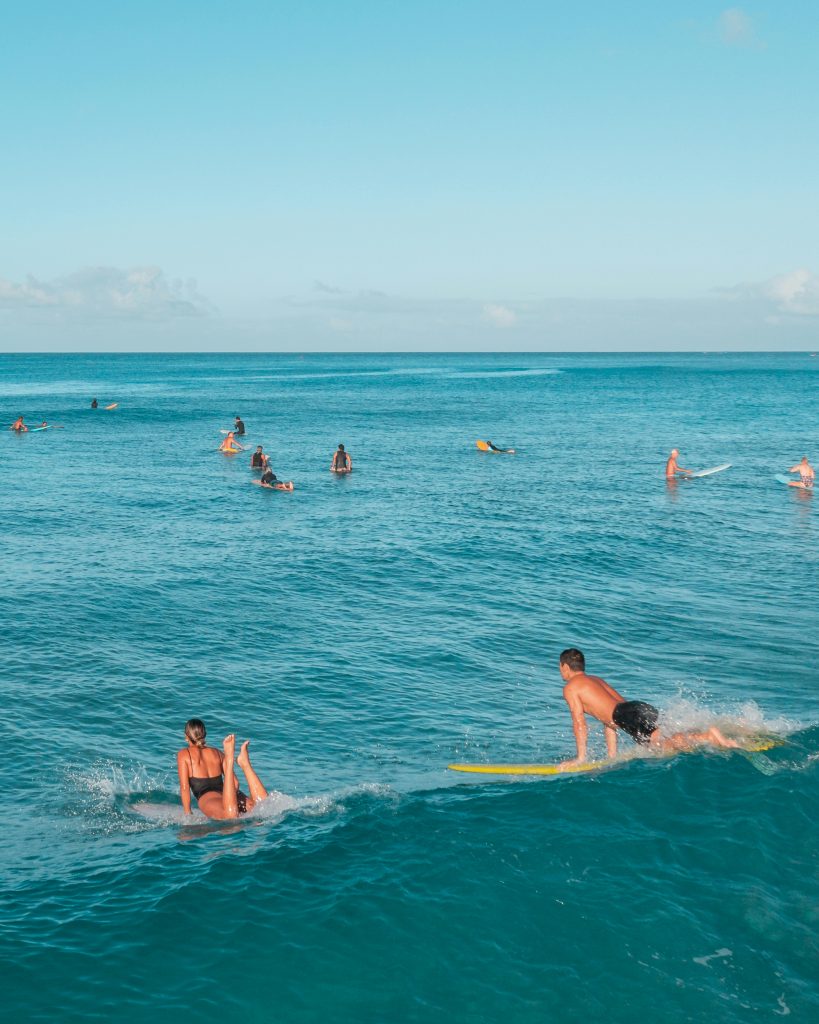How to paddle out on a surfboard: Follow these 5 steps to reach the lineup
- Written by Emilia
- Published March 27, 2024
Post contents
Introduction
When I first started surfing, one of my biggest fears was getting smashed by waves when paddling out to the lineup. By learning the steps and methods of how to paddle out on a surfboard (and getting smashed a couple of times while trying it), I got rid of my fear. I learned that it does not have to be that scary as long as you handle the approaching waves correctly.
In this lesson I will share what I have learned about how to paddle out on a surfboard effectively, without getting knocked over by incoming waves. I will also share three methods that I think are appropriate for beginners to use when a breaking wave approaches, as well as which method to use in what situation.
Step 1: Look for the best spot to paddle out
The first step of how to paddle out on a surfboard to the lineup starts on land. Before you enter the water, spend a moment on the beach to observe the ocean and other surfers:
- Identify at what spot(s) in the water other surfers are paddling out, and what route they are taking to reach the lineup.
- Seek out channels or spots where the waves seem quieter. These areas offer smoother paths for paddling.

Step 2: Walk your board out as far as you can
The second part of how to paddle out on a surfboard to the lineup, is to walk your board out into the water as far as you can- so not actually starting the paddling yet. You should be able to walk out to about stomach-deep water. This way, you can save your energy for when you really need it.

Step 3: Wait for a moment of calm between waves before starting your paddle-out
Don’t rush! Waves usually come in sets and you should aim to paddle out in-between sets. So, wait for a break in the waves before you start paddling out. This gives you a better chance of getting through without getting knocked around too much.

Step 4: Get on your board and position yourself correctly
For the right positioning on the surfboard when paddling out, check out my lesson on how to achieve the correct position here. I also have another lesson that describes paddling technique for beginners more in-depth- check it out here if you are interested in paddling technique.
There are some common mistakes that beginners make when paddling out to the lineup. Let’s have a look at them next:
Mistake 1: They lay too far up on the board
A common mistake beginners make is positioning themselves too far forward on the board, which can result in a stationary or still position in the water. When stationary, you’re not moving forward with enough speed, making it easier for the wave to overpower you and push you back toward the shore.
Mistake 2: They lay too far down on the board
Another common mistake that beginners make when paddling out is being too far back on the board. That results in the wave hitting the bottom of the board, lifting it up in the air and knocking them backwards.
Mistake 3: They are not perpendicular to the wave
Not being perpendicular to the wave means that the nose of the board is not pointing directly towards the wave. If you’re not perpendicular to the wave, the wave will push you and your board backwards when it “grabs on” to the side of your board.

Step 5: Start paddling out and use the right method to get through breaking waves
Now to the fun part of how to paddle out on a surfboard; the different methods to use when an incoming, broken wave approaches you during your paddle-out!
There are a couple of different methods you can use to get through breaking waves when paddling out to the lineup. In this lesson, I will go through three different methods that I think are suitable for beginners and that work if you are riding a soft-top board.
Method 1: The cobra / plank

When to use this method:
- For waves that are around 1ft.
- For smaller waves that have less power.
As a beginner surfer, this is probably the method you’ll be using the most.
How to use this method:
- Ensure you’re facing the incoming wave directly. Your board should be perpendicular to the wave, meaning the nose of the board points straight towards the wave. If you’re not perpendicular to the wave, there’s a high chance it will push you back.
- Paddle towards the wave to gain speed. Having speed helps you maintain momentum and stability, making it easier to push through the wave.
- Push up into a cobra position or a plank position just as the wave hits the nose of your board. If you choose to do the cobra position, place your hands under your chest on the rails of the board and push up your upper-body. If you’d rather opt for the plank position, lift your full body up by extending your arms and lifting up your hips. Your hands should be places on the rails of the board.
- Come back down and continue paddling as soon as the wave passes the tail of your board.
Why use this method?
The goal is to let part of the wave pass between your body and the board, while the rest goes beneath the board. This technique prevents you from being pushed back towards the beach.
Method 2: The sit and spin

When to use this method:
- For waves that are around 2-3ft.
- For waves that are a little bit bigger where the cobra / plank technique does not work.
- For beginners that have not yet learned to turtle roll.
How to use this method:
- Sit on the tail of the board when the wave approaches you. Make sure you sit far back on the board, and that there are no surfers on the incoming wave close to you.
- Spin the board around, away from the wave. Your back should now be facing the wave. You can look over your shoulders to make sure your back is perpendicular to the wave.
- Grab your rails and lean back right before the white water hits you. If it’s a small white water wave, you do not need to lean back too much, but if it’s a bigger white water wave you should lean back quite a bit.
Why use this method?
Not all waves can be pushed through using the cobra or plank method- some waves are too big for that method to work well. The sit and spin method is a good substitute for the turtle roll if you have not yet learned the turtle roll method.
Method 3: The turtle roll

When to use this method:
For bigger waves that are around 2+ ft.
How to use this method:
- Ensure you’re facing the incoming wave directly. Your board should be perpendicular to the wave, meaning the nose of the board points straight towards the wave. If you’re not perpendicular to the wave, there’s a high chance it will push you back.
- Paddle towards the wave to gain speed. Having speed helps you maintain momentum and stability, making it easier to push through the wave.
- Flip over your board and yourself when the wave is 2 meters away from you. Do so by grabbing the rails of the board and put pressure on one of your rails until you and your board flip over.
- Once underwater, make sure you have a solid grip with bent arms. Do not keep your arms straight or locked. This helps you absorb the turbulence of the white water.
- Quickly flip the board board back over and start paddling out again, as soon as you feel that the wave has passed you. Getting paddling right away prevents you from being washed back into the shore.
This video from Lapoint camps explains the turtle roll method well if you’d like to see it “in action”.
Why use this method?
The turtle roll method enables you to conserve energy by utilizing the natural buoyancy of the board and rolling with the wave rather than fighting against it. In crowded lineups, this method is better than the sit and spin method as it does not require as much space. When done right, it also gives you a bit more control of the board compared to the sit and spin method.

Lesson quiz: test your knowledge

Time's up
I’d love to hear your thoughts on this post! Whether you have suggestions for improvement, want to share what you liked, or have any questions, feel free to leave a comment below. Your feedback helps me create better content for all aspiring surfers!